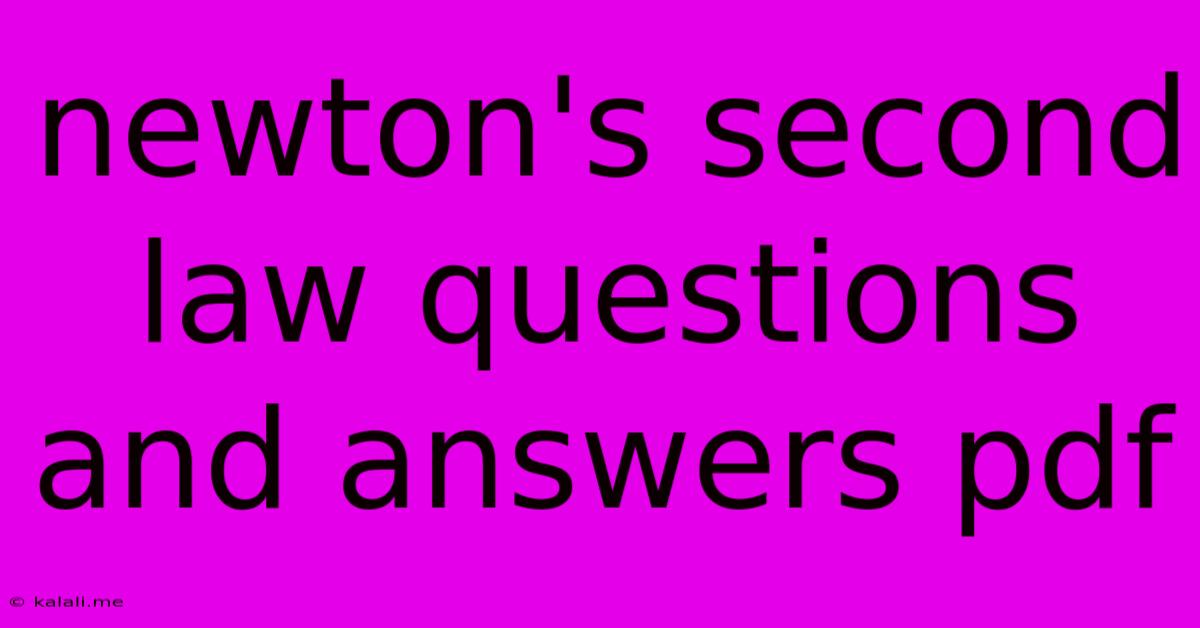Newton's Second Law Questions And Answers Pdf
Kalali
Jun 14, 2025 · 3 min read

Table of Contents
Newton's Second Law: Questions and Answers
Meta Description: Struggling with Newton's Second Law? This comprehensive guide provides a range of questions and answers, clarifying concepts like force, mass, acceleration, and their relationships. Master this fundamental law of physics with our helpful explanations.
Newton's Second Law of Motion is a cornerstone of classical mechanics, describing the relationship between force, mass, and acceleration. Understanding this law is crucial for anyone studying physics, engineering, or related fields. While a simple equation (F = ma), its applications can be surprisingly diverse and challenging. This article aims to clarify common misconceptions and provide a robust understanding through a series of questions and answers.
Understanding the Fundamentals: Force, Mass, and Acceleration
Before diving into complex problems, let's solidify the basics.
Q1: What is Newton's Second Law of Motion?
A1: Newton's Second Law states that the acceleration of an object is directly proportional to the net force acting on it and inversely proportional to its mass. This is mathematically represented as F = ma, where:
- F represents the net force (in Newtons)
- m represents the mass (in kilograms)
- a represents the acceleration (in meters per second squared)
Q2: What is the difference between mass and weight?
A2: Mass is a measure of the amount of matter in an object, while weight is the force of gravity acting on that mass. Mass remains constant regardless of location, whereas weight changes depending on the gravitational field strength. On Earth, weight is approximately equal to mass multiplied by the acceleration due to gravity (9.8 m/s²).
Q3: What does "net force" mean in the context of Newton's Second Law?
A3: Net force is the vector sum of all forces acting on an object. If multiple forces are acting on an object, you must consider their direction and magnitude to determine the net force. Only the net force determines the object's acceleration.
Applying Newton's Second Law: Problem Solving
Let's tackle some practical applications of Newton's Second Law.
Q4: A 10 kg object experiences a net force of 20 N. What is its acceleration?
A4: Using F = ma, we can rearrange the equation to solve for acceleration: a = F/m. Therefore, a = 20 N / 10 kg = 2 m/s².
Q5: A 5 kg ball is rolling across a frictionless surface with an acceleration of 3 m/s². What is the net force acting on the ball?
A5: Using F = ma, we calculate the net force: F = 5 kg * 3 m/s² = 15 N.
Q6: How does friction affect the application of Newton's Second Law?
A6: Friction is a force that opposes motion. When considering Newton's Second Law in real-world scenarios, friction must be included as a force acting on the object. This will reduce the net force and therefore the acceleration.
Q7: What is the significance of Newton's Second Law in understanding projectile motion?
A7: Newton's Second Law is fundamental to understanding projectile motion. The force of gravity constantly acts on a projectile, causing a downward acceleration. Analyzing the horizontal and vertical components of motion using Newton's Second Law allows us to predict the trajectory of the projectile.
Advanced Concepts and Considerations
Q8: How does Newton's Second Law apply to systems with multiple objects?
A8: For systems with multiple objects, you must consider the net force acting on each object individually. The forces between the objects (internal forces) cancel each other out when considering the system as a whole.
Q9: What are some limitations of Newton's Second Law?
A9: Newton's Second Law is a classical mechanics approximation. It breaks down at very high speeds (approaching the speed of light) and for objects with very small masses (at the atomic level), where relativistic effects and quantum mechanics become significant.
This collection of questions and answers provides a foundation for understanding and applying Newton's Second Law. Further exploration through practice problems and more advanced texts will solidify your comprehension of this essential concept in physics. Remember to always carefully consider the forces involved and their directions when solving problems.
Latest Posts
Latest Posts
-
Dialysis Can Be Used To Separate Solutions From Colloids
Jun 14, 2025
-
Which Of The Following Is Not An Intensive Physical Property
Jun 14, 2025
-
What Body Of Water Separates Africa And Europe
Jun 14, 2025
-
Advantages And Disadvantages Of Sprinkler Irrigation
Jun 14, 2025
-
Which Is An Example Of A Socialist Principle
Jun 14, 2025
Related Post
Thank you for visiting our website which covers about Newton's Second Law Questions And Answers Pdf . We hope the information provided has been useful to you. Feel free to contact us if you have any questions or need further assistance. See you next time and don't miss to bookmark.